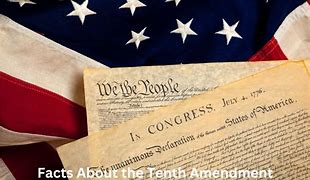Widgetized Section
Go to Admin » Appearance » Widgets » and move Gabfire Widget: Social into that MastheadOverlay zone
States’ Rights vs. The Powers of the Federal Government
The views expressed are those of the author and do not necessarily reflect the views of ASPA as an organization.
By Eric McLeod
April 18, 2025

At what point are states’ rights more or less important than the powers of the federal government? Article VI Paragraph 2 of the U.S. Constitution (1788), also known as the Supremacy Clause, establishes that the Constitution is the supreme law of the land. The 10th Amendment (1791), included in the Bill of Rights, guarantees that any powers not specifically delegated by the Constitution to the federal government belong to the states or to the people. When should the federal government step in and tell the states what they can and cannot do? Where is that covered in the United States Constitution?
In my article from March 4, 2024, I discussed the 10th Amendment of the Constitution through the lens of the legislation of slavery in this country. In the context of American history, this was a long time ago. One might find it easy to believe that as this country grew and matured with all of our advances in knowledge, understanding and technology, we surely no longer have these Constitutional issues between the states and the federal government—but one would be mistaken. The fact is these issues continue even at the time of this writing.
For much of this country’s history, the federal government has found ways to impose its will on the states and on the people. At times, this was done directly, as with the various decisions made regarding slavery and which states could be slave states. This manipulation and coercion of the states by the federal government has continued indirectly with cash. That is, the federal government has strongly influenced state policy through the use of federal grants such as categorical grants and block grants. Put more bluntly, the federal government offers states significant amounts of cash to do what the federal government wants, like standardized speed limits. At the same time, the federal government withholds these funds if a state refuses to do what the federal government wants.
Two of the more hotly debated issues currently are Roe v. Wade and the U.S. Department of Education. In a 1973 ruling, the U.S. Supreme Court created a Constitutional right that did not previously exist. That is, it was not previously a specific right or power named by the Constitution. Additionally, the judicial branch circumvented the Constitutional process of amending the Constitution through the voting power of Congress and the states. Similarly, in 1979, the federal government created the Department of Education as a cabinet-level department.
It was not until the last two and a half years that the federal government began efforts to align these two issues with the Constitution by returning the power of these decisions to the states. This began with the Supreme Court overturning its own ruling on Roe v. Wade in June of 2022. In this ruling, the Court determined that it was not for the federal government to decide but that it was the right of each individual state to do so.
With the signing of Executive Order 14242 “Improving Education Outcomes by Empowering Parents, States and Communities” on March 20, 2025, began the process of dismantling the U.S. Department of Education. This is a department that currently spends $60 billion annually on local schools. Remember the previous discussion about federal grants? By cutting federal funding and dismantling the Department of Education, the federal government is returning the control of public schools in the United States back to the individual states, as it always should have been.
While not part of the Department of Education, the U.S. Department of Agriculture (USDA) oversees and funds several public school meal programs like the National School Lunch Program (NSLP – $17.2 billion), the School Breakfast Program (SBP – $8.3 billion) and the Strengthen School Meals Program (SSMP – $1.5 billion). This is yet another federal department spending $27 billion annually in federal grants to control local schools. As with all federal grant programs, in theory, the states have the right to exercise their own powers and not bow to the wishes of the federal government, but then they would have to give up the funding being offered.
Would democracy work if we did away with the 10th Amendment and states’ rights altogether? Instead, all of the states would come under the control of the rules and laws of the federal government, administered by the individual states with federal oversight, creating one true central government known as a unitary government. This form of government has had varying levels of success in countries like France, Japan and the United Kingdom. However, this would not be a democracy, and the United States was founded as a democracy. What would happen to having a government of the people, by the people, for the people?
Author: Eric McLeod has a Master of Public Administration from California Baptist University in Southern California. He is currently in the DPA program at CBU. He has served the public for over 17 years with the Riverside County Sheriff’s Department. Initially, he worked in crime scene investigations with their forensics unit. He is currently a deputy coroner with the department, conducting death investigations. Email: [email protected]




Follow Us!